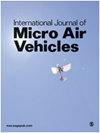基于梯度下降的高速飞行模型参数与状态估计
IF 1.6
4区 工程技术
Q2 ENGINEERING, AEROSPACE
引用次数: 4
摘要
GPS拒绝环境下的高速飞行是目前微型飞行器自主飞行研究的一个重要前沿。自动无人机比赛通过呈现一个非常具有挑战性的案例来刺激这一领域的进步,该案例具有紧凑的转弯、无纹理的地板和赛道周围充满活力的观众。这些特性阻碍了标准视觉里程计方法的使用,并意味着微型飞行器将不得不在没有位置反馈的情况下跨越相当长的时间间隔。为此,我们提出了一种无人机比赛轨迹估计方法,该方法计算效率高,但能够基于对比赛门的稀疏、噪声观测准确估计微型飞行器的状态(包括偏差)和参数。该方法的关键概念是优化未知和难以观测的状态变量,以便在一个时间窗口内,对赛车门的观测与已知的控制输入、估计的姿态以及四旋翼动力学和空气动力学最为吻合。结果表明,与最先进的15状态扩展卡尔曼滤波器相比,所提出方法的梯度下降实现收敛到(近似)校正偏差值的速度快4倍。此外,它达到了更高的精度,因为开环转弯的预测终点距离实际终点平均只有~20厘米,而扩展卡尔曼滤波器和带有运动学模型的梯度下降方法仅达到~50厘米的精度。尽管该方法在这里应用于无人机比赛,它推广到其他设置,在这些设置中,微型飞行器可能只能稀疏地访问速度和/或位置测量。本文章由计算机程序翻译,如有差异,请以英文原文为准。
In-flight model parameter and state estimation using gradient descent for high-speed flight
High-speed flight in GPS-denied environments is currently an important frontier in the research on autonomous flight of micro air vehicles. Autonomous drone races stimulate the advances in this area by representing a very challenging case with tight turns, texture-less floors, and dynamic spectators around the track. These properties hamper the use of standard visual odometry approaches and imply that the micro air vehicles will have to bridge considerable time intervals without position feedback. To this end, we propose an approach to trajectory estimation for drone racing that is computationally efficient and yet able to accurately estimate a micro air vehicle’s state (including biases) and parameters based on sparse, noisy observations of racing gates. The key concept of the approach is to optimize unknown and difficult-to-observe state variables so that the observations of the racing gates best fit with the known control inputs, estimated attitudes, and the quadrotor dynamics and aerodynamics during a time window. It is shown that a gradient-descent implementation of the proposed approach converges ∼4 times quicker to (approximately) correct bias values than a state-of-the-art 15-state extended Kalman filter. Moreover, it reaches a higher accuracy, as the predicted end-point of an open-loop turn is on average only ∼20 cm away from the actual end-point, while the extended Kalman filter and the gradient descent method with kinematic model only reach an accuracy of ∼50 cm. Although the approach is applied here to drone racing, it generalizes to other settings in which a micro air vehicle may only have sparse access to velocity and/or position measurements.
求助全文
通过发布文献求助,成功后即可免费获取论文全文。
去求助
来源期刊

International Journal of Micro Air Vehicles
ENGINEERING, AEROSPACE-
CiteScore
3.00
自引率
7.10%
发文量
13
审稿时长
>12 weeks
期刊介绍:
The role of the International Journal of Micro Air Vehicles is to provide the scientific and engineering community with a peer-reviewed open access journal dedicated to publishing high-quality technical articles summarizing both fundamental and applied research in the area of micro air vehicles.
 求助内容:
求助内容: 应助结果提醒方式:
应助结果提醒方式:


